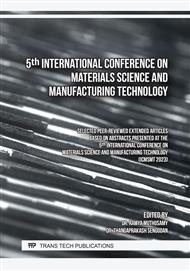p.57
p.65
p.73
p.81
p.93
p.103
p.111
p.125
p.137
Performance Analysis of the Protection Effect Cow Bone and Coconut Shell Particulates on 1170 Aluminium Alloy in Dilute Electrolytes
Abstract:
Particulates of cow bone (CB) and coconut shell (CS) were infused within the microstructure of 1170 aluminium alloy and studied for their influence on the corrosion resistance of the resulting aluminium matrix composites in 3.5% NaCl, 0.05 M H2SO4 and 3.5% NaCl/0.05 M H2SO4 solution by weight loss method. Corrosion rate data shows CB and CS significantly influenced the electrochemical properties of the composite. Protection performance data at 336 h of exposure shows CB and CS particulate significantly reduced the corrosion resistance of the aluminium alloy at all weight compositions in 3.5% NaCl solution. In 0.05% H2SO4 solution, CB improved the corrosion resistance of the composite at 5% - 15% weight composition (37.8%, 23.22% and 23.22%), while CS improved the corrosion resistance at 10% and 20% weight composition (37.65% and 28.52%). The corresponding values for CB in 3.5% NaCl/0.05 M H2SO4 solution occurred at 5% - 15% weight composition (34.26, 31.71% and 22.68%) while for CS it occurred at 10 and 15% weight composition (40.52% and 46.05%). Data from ANOVA statistical tool shows particulate weight composition and exposure time are both relevant determinant variables (greater than the theoretical significance factor) influencing the protection performance outputs of CB and CS with values ranging between 41.82% to 92.5% for weight composition and 5.68% and 53.03% for exposure time. Standard deviation data for CB particulate varied minimally only at 20% weight composition in 3.5% NaCl solution. The corresponding data at other CB weight compositions and for coconut shell at all weight compositions varied significantly due to thermodynamic instability.In 0.05 M H2SO4 and 3.5% NaCl/0.05 M H2SO4 solutions, all standard deviation values for CB and CS particulates (excluding CB at 29% weight composition) at all weight compositions vary minimally from the mean data signifying thermodynamic stability of the electrochemical reactions on the composite surfaces with respect to exposure time. The proportion of data above 20% protection performance for CB and CS particulates in 3.5% NaCl solution is 0% at margins of error of 0%. The corresponding values in 0.05 M H2SO4 solution are 15.18% and 15.32% at margins of error of 40% and 43% while the values from 3.5% NaCl/0.05 M H2SO4 solution are 14.78% and 15.5% at margins of error of 35% and 50%.
Info:
Periodical:
Pages:
93-102
Citation:
Online since:
October 2023
Keywords:
Price:
Сopyright:
© 2023 Trans Tech Publications Ltd. All Rights Reserved
Share:
Citation:



